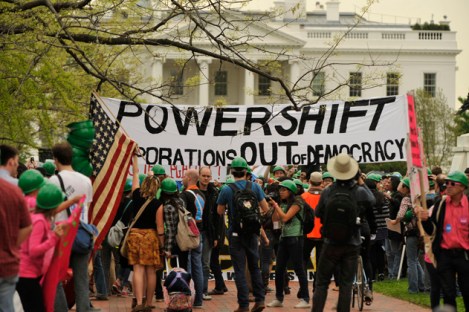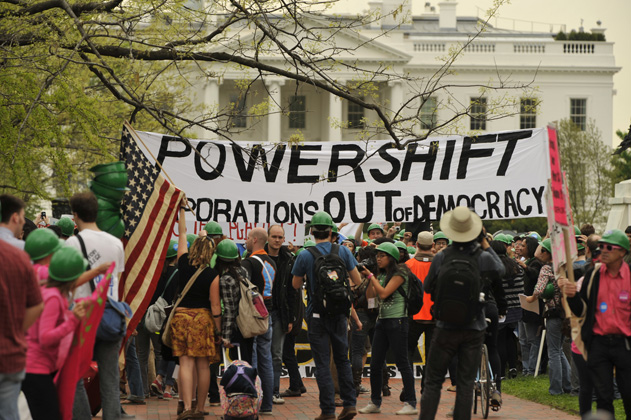The environmental movement’s challenge isn’t energy, it’s power.
Power is what prompts political change. Shifts in power, application of power. Not necessarily power on Capitol Hill, but at least enough power to force Capitol Hill to act. Environmentalists lack the power necessary to effect any major change because there are only a few environmental champions in positions of power in the United States: a few in the private sector, a few in Congress, a very few in the administration, almost no one in the media.
In order to make change, the movement needs to build political power. But instead it’s consumed with building energy in an already-energetic base.

Young people protest during Powershift 2011.
As David Roberts notes here and as I’ve noted before, passion and energy are critical to change. Without passion and a desire to make the status quo snap, nothing happens. But that passion has to exist within the powerful. And right now it doesn’t.
Last weekend, tens of thousands of protestors met on the Mall in Washington, D.C., to demand that the president reject the Keystone XL pipeline. Organizers celebrated the turnout, hailing it as the largest climate rally in history.
That may be, but it’s certainly not the largest environmental rally in history. On the first Earth Day in 1970, an estimated 1 million people rallied just in New York City, and nearly 20 million across the country. In 2000, a large Earth Day rally in D.C. was mirrored throughout the country. While those were more broadly focused on the environment, they likely matched last weekend’s crowd in energy. And large swaths of every such crowd shared a similar message: Take action to protect the Earth. Only the specifics varied.
The environmental movement has been sparking passion in the U.S. for more than 40 years, and calling on the government to act. At one time the government did: President Nixon created the EPA the same year as those first rallies. Change was effected because that passion occurred among the powerful: A broad swath of voters in the 1970s supported improving the environment, Gallup notes; Congress passed the Clean Air and Clean Water Acts. Energy coupled with power made change.
What environmental organizations failed to do was institutionalize that power. Rallies and petitions sparked change, so rallies and petitions remained prominent strategies for decades. That power trickled away as the environment improved and core activists aged and the fossil fuel industry and other polluters increasingly wielded their own power. When the climate crisis burst into national consciousness with An Inconvenient Truth, environmental organizations knew how to file lawsuits against the EPA and hold rallies, but weren’t prepared to deal with the energy of new supporters. 350.org stepped into the vacuum, but without a plan for building political power, it, too, has seen limited success. American voters en masse are a powerful group, but their passion has dissipated.
Rallies like last Sunday’s won’t change that. Consider it from the point of view of a non-activist. Without political power and without powerful champions in the media, rally organizers were able to generate only limited awareness of the event. Democracy Now! covered the rally, but non-activists don’t watch Democracy Now! [Editor’s note: 350.org points out that Sunday’s rally got a fair bit of coverage from the mainstream media.] Had they watched it, they would have seen protestors, mostly young, carrying signs with pictures of the Earth and various slogans. In short: They would have seen little they hadn’t seen before. The rally may have whipped up some passion, but it was almost certainly among the already-passionate.
This is the media’s fault, yes. But the media only covers what it is convinced is important. There are two times the media has given widespread coverage to climate change lately. The first was when Sandy demolished the East Coast; the second, when President Obama raised the topic in his inauguration and State of the Union speeches. In the case of Sandy, we had a (frightening, deadly) aberration from the norm. In the case of Obama, he wields power. The rally last weekend had neither of those qualities. Fifty thousand people from various parts of the country may be a lot of people, but it’s not a lot of political power.
So how can the environmental movement make the passionate powerful — or how can it make the powerful passionate? Sandy prompted Obama to show passion on climate change. As time progresses, other disasters will likely spur other powerful entities to act. But if the goal is to prevent those disasters, there needs to be another strategy.
On Wednesday, Politico outlined political spending by PACs in January. ExxonMobil spent $51,000. BP spent $4,000. A Michigan utility spent $65,500. The National Mining Association spent $26,000. The League of Conservation Voters spent $1,300.
Spending money is not the only way to build political power. But building political power, in the form of building allies in Congress and in statehouses, does require investment. National environmental organizations have massive, inert, largely dispassionate memberships. There’s nascent power in that, but power that is largely uncoupled from energy.
What if environmental organizations pooled resources into a PAC that could target political races? What if those organizations asked their millions of members to get involved in politics? What if the unprecedented shift the Sierra Club took wasn’t its executive director spending an hour at a D.C. police station but was instead an insistence that the time for political apathy had ended? If that happened, if hundreds of thousands of members donated time and money and new bursts of energy to politics? Then we might see change.
Then we might get hard-green members of Congress, holding that body hostage to the demands of the future in the same way that no-tax extremists now hold it hostage to the past. There might be reason for the allies of fossil fuels to fear every other November, as this mega-PAC poured money and local volunteers into primary elections. There might be media coverage of this new entity shaking up American politics, leveraging the assets and passions of Americans to actually effect change.
This is not a quick strategy. It would be a deliberate, forceful tool for establishing a bulwark within the American political infrastructure. It would force the sort of conflict that needs to be forced — not between greens outside the White House gates and the Democratic president within, but between well-funded activists and the favored congressmembers of fossil fuel companies. It would require environmental organizations to put the environment over their own best interests, which is never easy for any institution.
But what activists are doing is what activists have always done, and it isn’t working. The question isn’t whether the Keystone XL pipeline is blocked, it’s whether the established power structure in the United States is willing to combat climate change. Even if the answer to the first is yes, the answer to the second is clearly no. That’s the problem that needs to be fixed.



